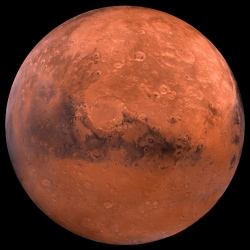
If NASA really wants to send humans to Mars in the 2030s, it needs to up its game. That’s according to the latest report from the Aerospace Safety Advisory Panel that advises NASA on safety issues. The report raises some serious safety concerns over the rocket and spacecraft that will send astronauts to Mars.
The report also says that NASA’s overall plan to get to Mars is too vague.
Although [a recent NASA report] does identify a few specific technologies that will be needed to accomplish the overall mission, including Solar Electric Propulsion and a Deep Space Habitat, it lacks a top-level architecture and/or design reference mission. Without these elements, it will be difficult to properly scope and sequence the needed technology development efforts to ensure that they will be available at the appropriate time.
The lack of a clearly defined plan could put the "Journey to Mars" at risk.
When questioned about the lack of a specific mission plan, senior NASA leaders have replied that it is too early for such plans. They are reluctant to design vehicles or missions with today’s technologies, since it is hoped that improvements can be made in the next 20 years that would radically change how such systems could be built.
Part of the problem, as the report points out, is political uncertainty. NASA scientists spent years during the Bush administration planning the Constellation program, a plan to send humans back to the moon and then on to Mars, which mostly got scrapped.
However, by not spelling out a clearly defined plan for getting to Mars, the space agency could be putting the Journey to Mars program at risk.
The pannel believes that a well-designed mission, with anticipated rewards that are expected to outweigh the risks, would go a long way toward gaining the needed support from future administrations, the Congress, and the general public.
If not, then perhaps NASA should be working on a different mission, or at least using a different approach for the current mission.
We should also consider going back to the moon before Mars, according to the report. Everyone and their brother is taking aim at the moon these days, from the European Space Agency to Russia and private companies. Plus, says the report, it is “unclear how NASA will develop low-gravity surface experience and technology without lunar surface experience.”
It makes sense that we should learn to live on the moon before going all the way to the red planet. But it would also come at an added cost to the already cash-strapped space agency. And it will probably require an Administration change; President Obama’s attitude toward human exploration of the moon is basically “been there, done that.”
Continuing the ISS past 2024 may delay the Journey to Mars. Finally, it looks like NASA may have to choose between maintaining the International Space Station and getting to Mars.
Not having to pay for ISS operations presumably would free up several billion dollars per year that could then be devoted to activities in cislunar space and beyond. However, some NASA managers (as well as industry partners) have spoken publicly about the benefits of continuing to operate the ISS until 2028, or even later.
While there may be benefits from such a plan, unless NASA were to be given a large increase in its appropriations, it is possible that continuing the ISS past 2024 may delay the Journey to Mars due to limited funding.
America’s space agency has some tough choices ahead. NASA is often praised for doing so much on such a relatively small budget, but lately it seems the agency is spreading itself too thin. Sometimes, less is more.
